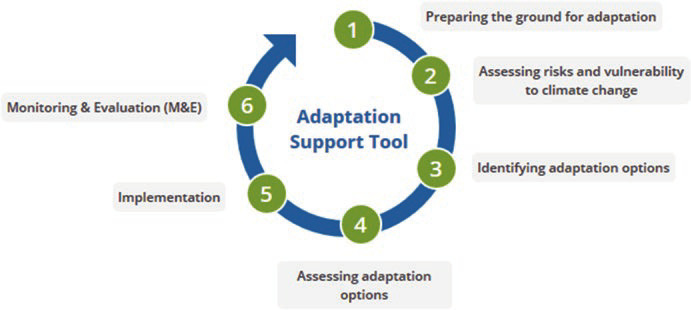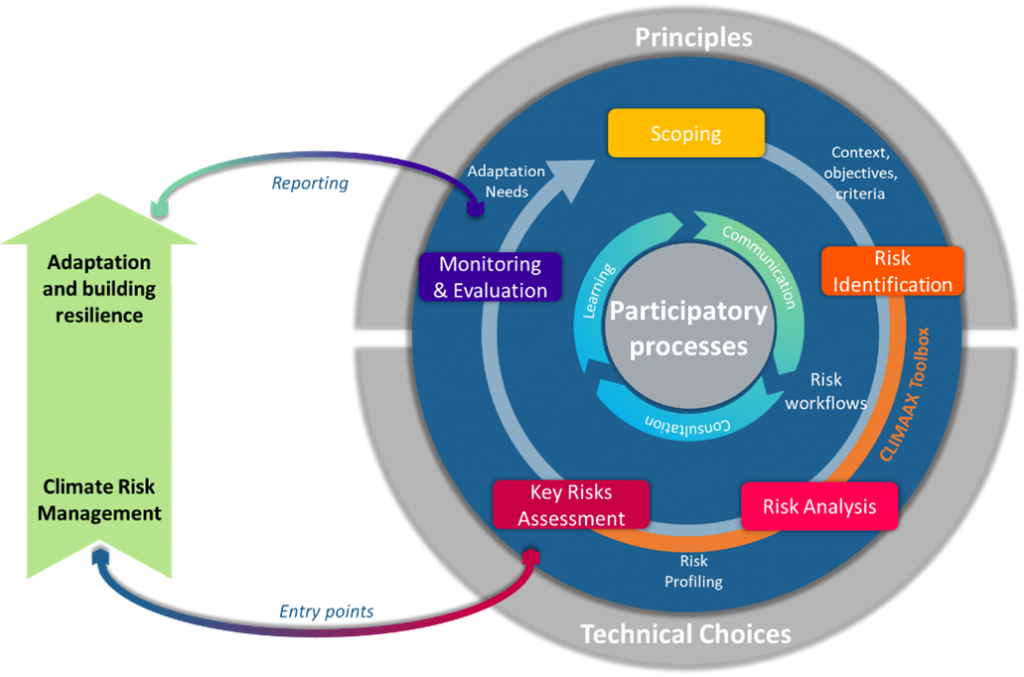The CLIMAAX methodological framework is designed to encompass and support inclusive and harmonised regional climate risk assessments (CRAs). The framework translates the ambitions of the EU Mission on Adaptation into practice. This EU mission unites European regions in their pathway to resilience and ability to cope with climate extremes by implementation of transformational adaptation and emergency management strategies. This is supported by the European Environment Agency, who has developed the Regional Adaptation Support Tool (RAST) that provides practical guidance to planning, implementation and evaluation of climate adaptation strategies. This tool is based on the Adaptation Support Tool logic displayed below.

Adaptation Support Tool outline. The CLIMAAX CRA Framework covers steps 1-3 in this scheme.
The CLIMAAX CRA Framework covers steps 1-3 from the Regional Adaptation Support Tool. It includes an inventory of the scope and institutional background of the CRA (RAST Step 1), ensuring embedding of the CRA in a shared strategic and institutional framework across actors/stakeholders for adaptation planning and risk management. It provides guidance on the selection of sound technical choices for conducting climate risk assessments (RAST Step 2). And it outlines the contribution of a regional CRA to transformational adaptation and emergency management strategies that build resilience (RAST Step 3). Support for assessment and implementation of regional adaptation strategies is provided by a.o. the Pathways2Resilience project funded by the European Mission on Adaptation.

The Climate Risk Assessment Framework shown in relation to its relationship with Climate Risk Management and adaptation and building resilience.
The figure above (also shown in Figure 1 of the Guide for applicants) displays how the CLIMAAX CRA Framework links to and supports climate risk management, adaptation and building resilience. The main steps in the framework are as follows:
Scoping
The first step of the risk assessment cycle is to determine context, objectives and criteria, which are embedded in a pre-defined set of principles.
Risk identification
A systematic inventory of relevant risks for the region of interest, guided by a survey of past experiences, records of data for multiple climate hazards (floods, drought, heatwave, fire, snow, wind), and exposure and vulnerability information derived from geographical and socio-economic characteristics of the region.
Risk analysis
The analysis of climate risks is conducted by risk assessment methods implemented in the CLIMAAX Toolbox in so-called “risk workflows”. Quantitative risk assessments are explored, for example, by using future scenarios and probabilistic or event-based approaches. Guidance is provided on the choice of data and scenarios for hazard, exposure and vulnerability.
Key risk assessment
Key risks that are particularly important in the local context are identified, to guide prioritization of upcoming climate risk management strategies. Special attention is paid to the combination of hazards that may amplify all or some of these risks.
Monitoring and evaluation
By systematic monitoring and evaluation of key risks and the effectiveness of adaptation and risk management actions an iterative repetition of the risk assessment cycle is fueled with new insights for updated the scoping and implementation of CRAs and adaptation strategies.
The framework is designed to provide a reference for defining climate risk assessment workflows and their implementation that are consistent with the highest standards, best practices and state-of the art scientific findings. In particular, the Framework gives guidance on:
- Stakeholder engagement processes that ensure development of appropriate CRA’s and uptake into strategic planning;
- Selection of hazards that have shown or are known to have a substantial societal impact and will be affected by climate change;
- Use of available data and concepts containing meaningful information for the region or community of interest;
- Selection of indicators for meteorological or hydrological hazards and societal or ecological impacts that can be used for designing and monitoring adaptation and risk management strategies;
- Use of climate and socio-economic scenarios that are relevant for impacts and risks that needs to be accounted for regions and communities for adaptation/risk management strategies.


